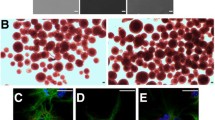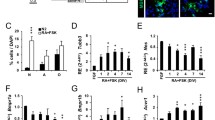Abstract
Correct timing and spatial location of growth factor expression is critical for undisturbed brain development and functioning. In terminally differentiated cells distinct biological responses to growth factors may depend on cell type specific activation of signalling cascades. We show that the hematopoietic growth factors thrombopoietin (TPO) and granulocyte colony-stimulating factor (GCSF) exert cell type specific effects on survival, proliferation and the degree of phosphorylation of Akt1, ERK1/2 and STAT3 in rat hippocampal neurons and cortical astrocytes. In neurons, TPO induced cell death and selectively activated ERK1/2. GCSF protected neurons from TPO- and hypoxia-induced cell death via selective activation of Akt1. In astrocytes, neither TPO nor GCSF had any effect on cell viability but inhibited proliferation. This effect was accompanied by activation of ERK1/2 and inhibition of STAT3 activity. A balance between growth factors, their receptors and signalling proteins may play an important role in regulation of neural cell survival.







Similar content being viewed by others
Abbreviations
- ECL:
-
enhanced chemoluminescence
- EPO:
-
erythropoietin
- ERK:
-
extracellular signal-regulated kinase
- FCS:
-
foetal calf serum
- GCSF:
-
granulocyte colony-stimulating factor
- GFAP:
-
glial fibrillary acidic protein
- GH:
-
growth hormone
- JAK:
-
Janus kinase
- MAP:
-
microtubule-associated protein
- OGD:
-
oxygen/glucose deprivation
- NF-200:
-
neurofilament 200
- PI3K:
-
phosphatidylinositol-3′ kinase
- STAT:
-
signal transducer and activator of transcription
- TPO:
-
thrombopoietin
References
Huang EJ, Reichardt LF (2003) Trk receptors: roles in neuronal signal transduction. Annu Rev Biochem 72:609–642
Sakanaka M, Wen TC, Matsuda S, Masuda S, Morishita E, Nagao M, Sasaki R (1998) In vivo evidence that erythropoietin protects neurons from ischemic damage. Proc Natl Acad Sci USA 95:4635–4640
Bernaudin M, Marti HH, Roussel S, Divoux D, Nouvelot A, MacKenzie ET, Petit E (1999) A potential role for erythropoietin in focal permanent cerebral ischemia in mice. J Cereb Blood Flow Metab 19:643–651
Scheepens A, Sirimanne ES, Breier BH, Clark RG, Gluckman PD, Williams CE (2001) Growth hormone as a neuronal rescue factor during recovery from CNS injury. Neuroscience 104:677–687
Shingo T, Sorokan ST, Shimazaki T, Weiss S (2001) Erythropoietin regulates the in vitro and in vivo production of neuronal progenitors by mammalian forebrain neural stem cells. J Neurosci 21:9733–9743
Yu X, Shacka JJ, Eells JB, Suarez-Quian C, Przygodzki RM, Beleslin-Cokic B, Lin CS, Nikodem VM, Hempstead B, Flanders KC, Costantini F, Noguchi CT (2002) Erythropoietin receptor signalling is required for normal brain development. Development 129:505–516
Dame C, Wolber EM, Freitag P, Hofmann D, Bartmann P, Fandrey J (2003) Thrombopoietin gene expression in the developing human central nervous system. Brain Res Dev Brain Res 143:217–223
Schabitz WR, Kollmar R, Schwaninger M, Juettler E, Bardutzky J, Scholzke MN, Sommer C, Schwab S (2003) Neuroprotective effect of granulocyte colony-stimulating factor after focal cerebral ischemia. Stroke 34:745–751
Kleinschnitz C, Schroeter M, Jander S, Stoll G (2004) Induction of granulocyte colony-stimulating factor mRNA by focal cerebral ischemia and cortical spreading depression. Brain Res Mol Brain Res 131:73–78
Knabe W, Knerlich F, Washausen S, Kietzmann T, Sirén AL, Brunnett G, Kuhn HJ, Ehrenreich H (2004) Expression patterns of erythropoietin and its receptor in the developing midbrain. Anat Embryol (Berl) 207:503–512
Brines M, Cerami A (2005) Emerging biological roles for erythropoietin in the nervous system. Nat Rev Neurosci 6:484–494
Ehrenreich H, Hasselblatt M, Knerlich F, von Ahsen N, Jacob S, Sperling S, Woldt H, Vehmeyer K, Nave KA, Sirén AL (2005) A hematopoietic growth factor, thrombopoietin, has a proapoptotic role in the brain. Proc Natl Acad Sci USA 102:862–867
Schneider A, Kruger C, Steigleder T, Weber D, Pitzer C, Laage R, Aronowski J, Maurer MH, Gassler N, Mier W, Hasselblatt M, Kollmar R, Schwab S, Sommer C, Bach A, Kuhn HG, Schabitz WR (2005) The hematopoietic factor G-CSF is a neuronal ligand that counteracts programmed cell death and drives neurogenesis. J Clin Invest 115:2083–2098
Geddis AE, Linden HM, Kaushansky K (2002) Thrombopoietin: a pan-hematopoietic cytokine. Cytokine Growth Factor Rev 13:61–73
Schindler C, Strehlow I (2000) Cytokines and STAT signaling. Adv Pharmacol 47:113–174
Dong F, Qiu Y, Yi T, Touw IP, Larner AC (2001) The carboxyl terminus of the granulocyte colony-stimulating factor receptor, truncated in patients with severe congenital neutropenia/acute myeloid leukemia, is required for SH2-containing phosphatase-1 suppression of Stat activation. J Immunol 167:6447–6452
Zhang Y, Sun S, Wang Z, Thompson A, Kaluzhny Y, Zimmet J, Ravid K (2002) Signaling by the Mpl receptor involves IKK and NF-kappaB. J Cell Biochem 85:523–535
Ferrari G, Greene LA (1994) Proliferative inhibition by dominant-negative Ras rescues naive and neuronally differentiated PC12 cells from apoptotic death. Embo J 13:5922–5928
Yao R, Cooper GM (1995) Requirement for phosphatidylinositol-3 kinase in the prevention of apoptosis by nerve growth factor. Science 267:2003–2006
Dudek H, Datta SR, Franke TF, Birnbaum MJ, Yao R, Cooper GM, Segal RA, Kaplan DR, Greenberg ME (1997) Regulation of neuronal survival by the serine-threonine protein kinase Akt. Science 275:661–665
Hetman M, Kanning K, Cavanaugh JE, Xia Z (1999) Neuroprotection by brain-derived neurotrophic factor is mediated by extracellular signal-regulated kinase and phosphatidylinositol 3-kinase. J Biol Chem 274:22569–22580
Susen K, Heumann R, Blochl A (1999) Nerve growth factor stimulates MAPK via the low affinity receptor p75(LNTR). FEBS Lett 463:231–234
Sirén AL, Fratelli M, Brines M, Goemans C, Casagrande S, Lewczuk P, Keenan S, Gleiter C, Pasquali C, Capobianco A, Mennini T, Heumann R, Cerami A, Ehrenreich H, Ghezzi P (2001) Erythropoietin prevents neuronal apoptosis after cerebral ischemia and metabolic stress. Proc Natl Acad Sci USA 98:4044–4049
Ruscher K, Freyer D, Karsch M, Isaev N, Megow D, Sawitzki B, Priller J, Dirnagl U, Meisel A (2002) Erythropoietin is a paracrine mediator of ischemic tolerance in the brain: evidence from an in vitro model. J Neurosci 22:10291–10301
Um M, Lodish HF (2006) Antiapoptotic effects of erythropoietin in differentiated neuroblastoma SH-SY5Y cells require activation of both the STAT5 and AKT signaling pathways. J Biol Chem 281:5648–5656
Brewer GJ (1997) Isolation and culture of adult rat hippocampal neurons. J Neurosci Methods 71:143–155
Lewczuk P, Hasselblatt M, Kamrowski-Kruck H, Heyer A, Unzicker C, Sirén AL, Ehrenreich H (2000) Survival of hippocampal neurons in culture upon hypoxia: effect of erythropoietin. Neuroreport 11:3485–3488
Heyer A, Hasselblatt M, von Ahsen N, Hafner H, Sirén AL, Ehrenreich H (2005) In vitro gender differences in neuronal survival on hypoxia and in 17beta-estradiol-mediated neuroprotection. J Cereb Blood Flow Metab 25:427–430
Unzicker C, Erberich H, Moldrich G, Woldt H, Bulla J, Mechoulam R, Ehrenreich H, Sirén AL (2005) Hippocampal cannabinoid-1 receptor upregulation upon endothelin-B receptor deficiency: a neuroprotective substitution effect? Neurochem Res 30:1305–1309
Ehrenreich H, Kehrl JH, Anderson RW, Rieckmann P, Vitkovic L, Coligan JE, Fauci AS (1991) A vasoactive peptide, endothelin-3, is produced by and specifically binds to primary astrocytes. Brain Res 538:54–58
Hasselblatt M, Lewczuk P, Loffler BM, Kamrowski-Kruck H, von Ahsen N, Sirén AL, Ehrenreich H (2001) Role of the astrocytic ET(B) receptor in the regulation of extracellular endothelin-1 during hypoxia. Glia 34:18–26
Haas R, Murea S (1995) The role of granulocyte colony-stimulating factor in mobilization and transplantation of peripheral blood progenitor and stem cells. Cytokines Mol Ther 1:249–270
Jacobsen SE, Borge OJ, Ramsfjell V, Cui L, Cardier JE, Veiby OP, Murphy MJ Jr, Lok S (1996) Thrombopoietin, a direct stimulator of viability and multilineage growth of primitive bone marrow progenitor cells. Stem Cells 14(Suppl 1):173–180
Sirotkin AV, Sanislo P, Schaeffer HJ, Florkovicova I, Kotwica J, Bulla J, Hetenyi L (2004) Thrombopoietin regulates proliferation, apoptosis, secretory activity and intracellular messengers in porcine ovarian follicular cells: involvement of protein kinase A. J Endocrinol 183:595–604
Xia Z, Dickens M, Raingeaud J, Davis RJ, Greenberg ME (1995) Opposing effects of ERK and JNK-p38 MAP kinases on apoptosis. Science 270:1326–1331
Alessandrini A, Namura S, Moskowitz MA, Bonventre JV (1999) MEK1 protein kinase inhibition protects against damage resulting from focal cerebral ischemia. Proc Natl Acad Sci USA 96:12866–12869
Mori T, Wang X, Jung JC, Sumii T, Singhal AB, Fini ME, Dixon CE, Alessandrini A, Lo EH (2002) Mitogen-activated protein kinase inhibition in traumatic brain injury: in vitro and in vivo effects. J Cereb Blood Flow Metab 22:444–452
Subramaniam S, Zirrgiebel U, von Bohlen Und Halbach O, Strelau J, Laliberte C, Kaplan DR, Unsicker K (2004) ERK activation promotes neuronal degeneration predominantly through plasma membrane damage and independently of caspase-3. J Cell Biol 165:357–369
Stanciu M, Wang Y, Kentor R, Burke N, Watkins S, Kress G, Reynolds I, Klann E, Angiolieri MR, Johnson JW, DeFranco DB (2000) Persistent activation of ERK contributes to glutamate-induced oxidative toxicity in a neuronal cell line and primary cortical neuron cultures. J Biol Chem 275:12200–12206
Stanciu M, DeFranco DB (2002) Prolonged nuclear retention of activated extracellular signal-regulated protein kinase promotes cell death generated by oxidative toxicity or proteasome inhibition in a neuronal cell line. J Biol Chem 277:4010–4017
Raghupathi R (2004) Cell death mechanisms following traumatic brain injury. Brain Pathol 14:215–222
Six I, Gasan G, Mura E, Bordet R (2003) Beneficial effect of pharmacological mobilization of bone marrow in experimental cerebral ischemia. Eur J Pharmacol 458:327–328
Shyu WC, Lin SZ, Yang HI, Tzeng YS, Pang CY, Yen PS, Li H (2004) Functional recovery of stroke rats induced by granulocyte colony-stimulating factor-stimulated stem cells. Circulation 110:1847–1854
Teixeira A, Chaverot N, Strosberg AD, Cazaubon S (2000) Differential regulation of cyclin D1 and D3 expression in the control of astrocyte proliferation induced by endothelin-1. J Neurochem 74:1034–1040
Pebay A, Toutant M, Premont J, Calvo CF, Venance L, Cordier J, Glowinski J, Tence M (2001) Sphingosine-1-phosphate induces proliferation of astrocytes: regulation by intracellular signalling cascades. Eur J Neurosci 13:2067–2076
Wang H, Ubl JJ, Stricker R, Reiser G (2002) Thrombin (PAR-1)-induced proliferation in astrocytes via MAPK involves multiple signaling pathways. Am J Physiol Cell Physiol 283:C1351–1364
Fanton CP, McMahon M, Pieper RO (2001) Dual growth arrest pathways in astrocytes and astrocytic tumors in response to Raf-1 activation. J Biol Chem 276:18871–18877
Pascual M, Valles SL, Renau-Piqueras J, Guerri C (2003) Ceramide pathways modulate ethanol-induced cell death in astrocytes. J Neurochem 87:1535–1545
Isobe I, Maeno Y, Nagao M, Iwasa M, Koyama H, Seko-Nakamura Y, Monma-Ohtaki J (2003) Cytoplasmic vacuolation in cultured rat astrocytes induced by an organophosphorus agent requires extracellular signal-regulated kinase activation. Toxicol Appl Pharmacol 193:383–392
Abe K, Saito H (2000) The p44/42 mitogen-activated protein kinase cascade is involved in the induction and maintenance of astrocyte stellation mediated by protein kinase C. Neurosci Res 36:251–257
Lee SM, Nguyen TH, Park MH, Kim KS, Cho KJ, Moon DC, Kim HY, Yoon do Y, Hong JT (2004) EPO receptor-mediated ERK kinase and NF-kappaB activation in erythropoietin-promoted differentiation of astrocytes. Biochem Biophys Res Commun 320:1087–1095
Choi JS, Kim SY, Park HJ, Cha JH, Choi YS, Kang JE, Chung JW, Chun MH, Lee MY (2003) Upregulation of gp130 and differential activation of STAT and p42/44 MAPK in the rat hippocampus following kainic acid-induced seizures. Brain Res Mol Brain Res 119:10–18
Sriram K, Benkovic SA, Hebert MA, Miller DB, O’Callaghan JP (2004) Induction of gp130-related cytokines and activation of JAK2/STAT3 pathway in astrocytes precedes up-regulation of glial fibrillary acidic protein in the 1-methyl-4-phenyl-1,2,3,6-tetrahydropyridine model of neurodegeneration: key signaling pathway for astrogliosis in vivo? J Biol Chem 279:19936–19947
Bowman T, Garcia R, Turkson J, Jove R (2000) STATs in oncogenesis. Oncogene 19:2474–2488
Bromberg J (2002) Stat proteins and oncogenesis. J Clin Invest 109:1139–1142
Rahaman SO, Harbor PC, Chernova O, Barnett GH, Vogelbaum MA, Haque SJ (2002) Inhibition of constitutively active Stat3 suppresses proliferation and induces apoptosis in glioblastoma multiforme cells. Oncogene 21:8404–8413
Konnikova L, Kotecki M, Kruger MM, Cochran BH (2003) Knockdown of STAT3 expression by RNAi induces apoptosis in astrocytoma cells. BMC Cancer 3:23
Acknowledgments
This work has been supported by the DFG European Graduate Programme “Neuroplasticity: From Molecules to Systems” and by the DFG Research Center for Molecular Physiology of the Brain (CMPB, Göttingen).
Author information
Authors and Affiliations
Corresponding author
Rights and permissions
About this article
Cite this article
Byts, N., Samoylenko, A., Woldt, H. et al. Cell Type Specific Signalling by Hematopoietic Growth Factors in Neural Cells. Neurochem Res 31, 1219–1230 (2006). https://doi.org/10.1007/s11064-006-9149-0
Received:
Accepted:
Published:
Issue Date:
DOI: https://doi.org/10.1007/s11064-006-9149-0




